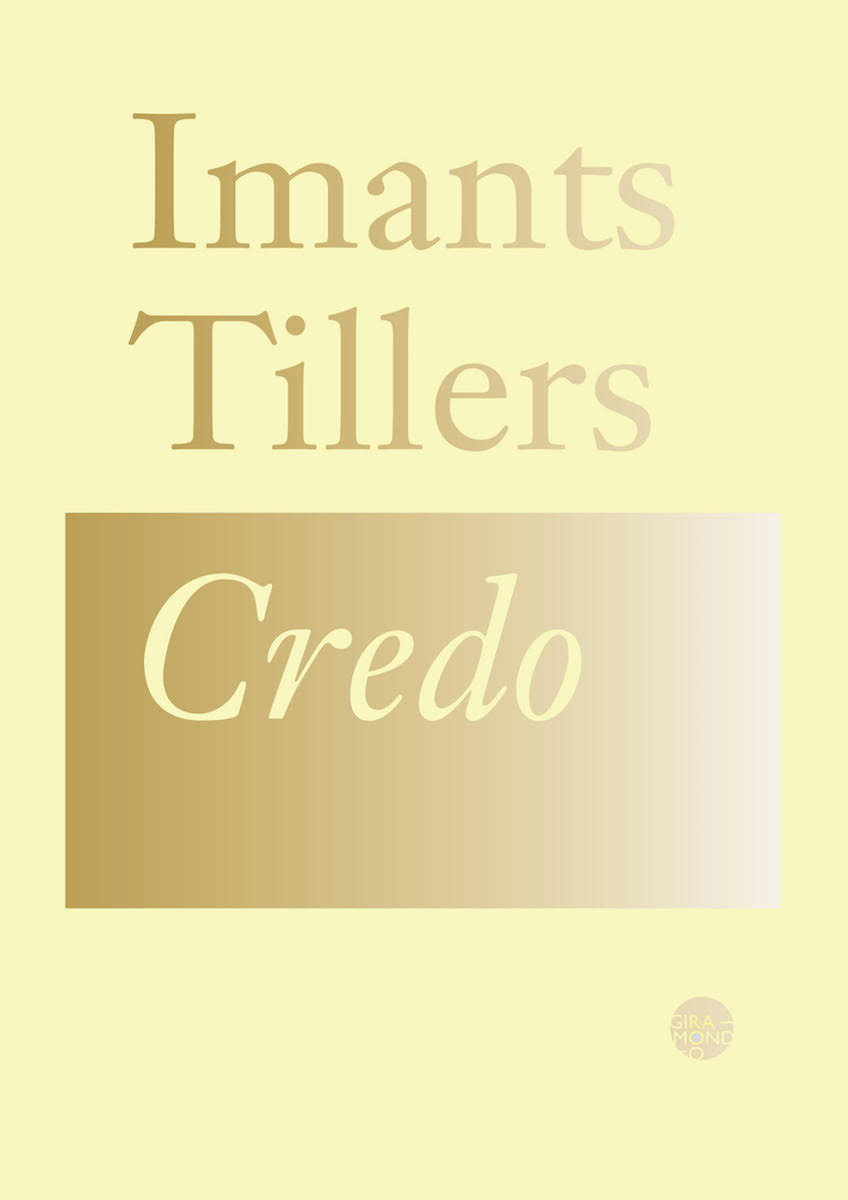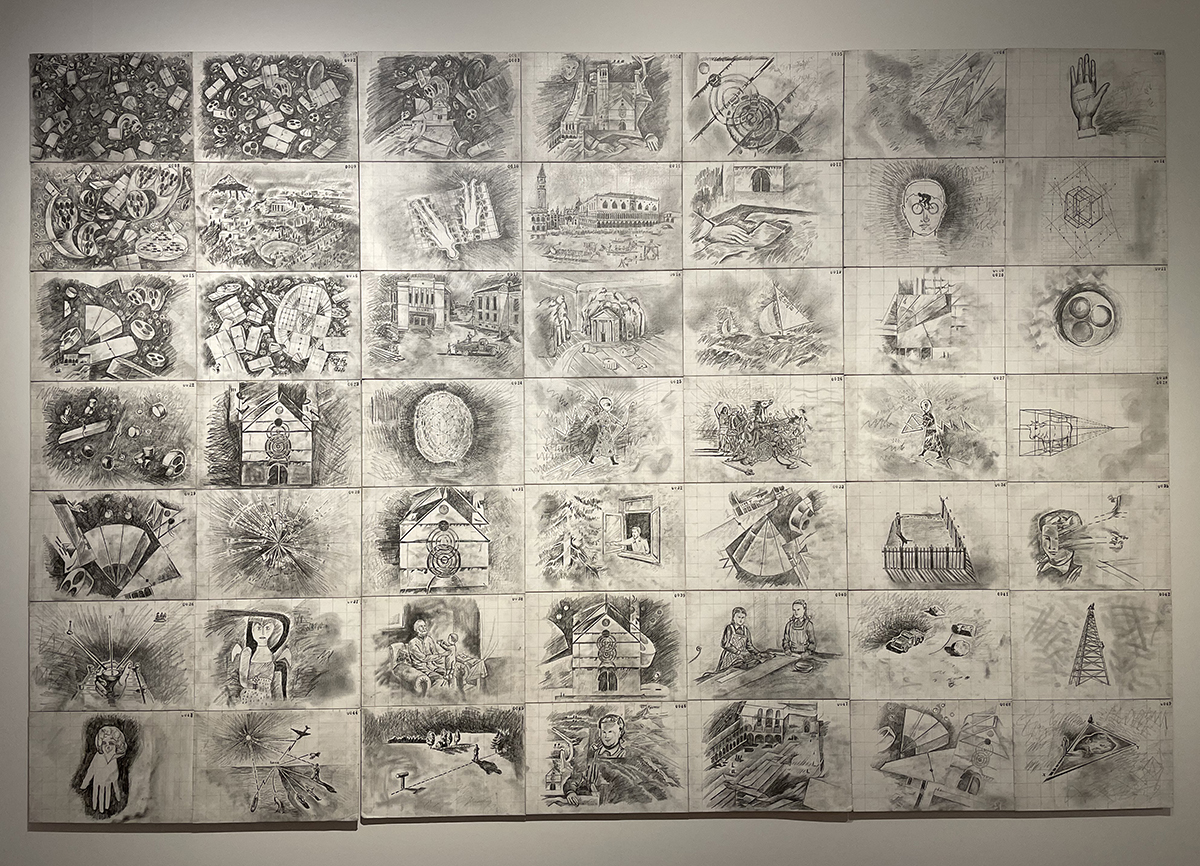
As for the notion of establishing some direct relationship between literature and the visual arts, I'm afraid I've begun by choosing Mallarme's Le Coup de Dés [The throw of the dice] as a subject!
– Marcel Broodthaers, 1973
Neither margin nor center are appropriate to Broodthaers's work.
– Benjamin Buchloh, 1987 [1]
While Imants Tillers’ art is renowned for its theoretical underpinnings, his book Credo is not a collection of shouting manifestoes or difficult theory. Easy on the eye and light in the hand, inside Credo we discover an amiable storyteller. Even its random dips in the esoteric depths of scientific theories do not distract from this journey through the life and mind of an artist with a knack for crystalising ideas in such readable prose.
Credo reveals that Tillers is an infinitely curious polymath with interests in mathematics, physics, cybernetics, the natural sciences, history, literature, philosophy and art: he also happens to be expert at overhauling long reigning paradigms of Australian art and modernism. This is evident in Credo’s first essay, the widely cited “Locality Fails” (1982). In upturning the axiomatic “provincialism problem” of Australian art and highlighting Indigenous painting at Papunya as both a conceptual art practice and a premonition of the future of contemporary art, “Locality Fails” prescience is striking. Further, its proposition of appropriation as a critical method has since become normative in contemporary art practices, effectively retrieving the ethical virtues of a practice much maligned by modernism.
“Locality Fails” was originally published in the leading Australian journal of postmodern art, Art & Text. Tillers had just started his ongoing signature project, the Book of Power. Consisting of sequentially numbered canvasboards on which he paints appropriations of artworks and references to his broad interests, its diaristic archive of artworld issues over the previous 40 years is mirrored in the collected essays penned during the same period. Originally written by invitation, they appear as “occasional papers” that Tillers refers to as Duchampian readymades because they arise by chance, in the moment rather than by some grand design or purpose, ready for publication. Yet there are consistent themes which result in anecdotes and ideas being repeated through the book, as indeed they do in his artwork. In refraining from editorial revisions, Credo retains the temporality of the originals: ‘I am not afraid of “repetition”’, said Tillers, it ‘is one of the fundamentals, not only of only my writing, but of my paintings as well.’
Credo reminds us of the central place of writing in Tillers’ painting practice. The statistics alone tell the story: as well as the essays published here, his growing archive contains 6,000+ pages of research notes bound in 100-page folders and untold written names, aphorisms and poems that have featured in his paintings since 1993—which account for over 70,000 of the 113,000+ canvasboards Tillers has painted since 1981. Further, his writing and painting share the same embodied technology: they are handwritten. There are no typewriters, computer programs, photographic tools or assistants in Tillers’ studio, but mountains of stacked books and canvasboards, and a desk where he paints and writes, often simultaneously.

A potent myth of modernism is that writing and painting are very different modes of thinking. For millennia painters were illiterate, proof that the painted image, born into an oral milieu of mnemonic poetic forms, has no need of writing. Nor has the emergence of widespread literacy in modernity’s print culture stemmed the proliferation of painting, or drawn many painters to engage extensively with writing. The transcribed oral interview remains the default publishing mode for most artists.
Tillers’ turn to writing is no turn away from orality; nor is it unique to his generation of conceptual artists. But few have made the relationship between text and pictures so crucial to their practice. The Book of Power imagines his paintings as printed pages, and their three ‘fundamental tenets’ of ‘quotation, appropriation and repetition’ emulate the logic of books, ensuring its volumes are potentially infinite. As if a generative AI machine, Tillers compared the Book of Power to an algorithm into which each painted page feeds accumulating data, an ever-expanding archive of images/texts that re-circulate in new permutations.
To say Tillers has a substantial library is an understatement. Tillers is a painter who lives in books. They lie open on his studio floor. It’s easy to see why. His paintings appropriate pictures and text as if the letters of the alphabet are as subject to the laws of visuality and aesthetics as they are to the semiosis of the sign, and can be read in both registers simultaneously. Hence his pictures appear as a type of writing, if only because they are embedded with ‘letters stolen from the alphabet’—to quote Tillers from “The Sources” (2019), the final essay of Credo. (He was quoting conceptual artist Marcel Broodthaers, in turn quoting the psychoanalyst Jacques Lacan. Their point: no utterance escapes ‘linguistic determination’.)
If Tillers seems determined to accommodate whatever inherent differences exist between writing and painting, he does not create a synthesis of them. Rather, he suggests another overarching order that mediates differences. Ever alert to chance juxtapositions of incommensurable things, he insinuates through this mediating metaphysics a lost relationship and disrupted destiny. For example, Credo’s first sentence (in “Locality Fails”) begins: ‘Albert Namatjira was born on 28 July 1902 sharing a birthday with Marcel Duchamp born in 1887’. By chance (‘a throw of the dice’) an iconic conceptual artist from the centre of the artworld appears next to an Indigenous artist from Hermannsburg, Central Australia—what Northern Territory tourist ads still call the middle of nowhere. Duchamp was a formative ancestor of Tillers’ early conceptual explorations, but it would be thirty years before Namatjira appeared as an ancestor in his art. In 1982 this destiny was unknown to Tillers, but mysteriously he had already written it, as if preordained by his communion with Duchamp.
Tillers speculated on this fantastical relation between Duchamp and Namatjira by invoking Bell’s Theorem, published by the physicist John Stewart Bell in 1964. First verified in 1972, it established that quantum particles remain entangled no matter how far distanced they are. Hence Tillers surmised that the incommensurability of Aboriginal and conceptual art, of centre and periphery (the provincialism problem of imperial power), of the original and the copy (the philosophical conundrum of representation), and the binary essentialisms of identity politics, can be overcome without compromising or assimilating their differences.
In his 1996 essay “Perturbations in the Image Field”, Tillers invoked Chaos Theory to the same ends. Its ‘spontaneous self-organisation of non-equilibrium systems’, in which turbulent friction in a dynamic field of indeterminate events creates a more overarching order, provides another model for the accommodation of differences without assimilation.
There is an ethic here—what Tillers calls ‘accommodating incommensurability as a model of tolerance’—and an epistemology akin to Jacques Derrida’s influential contemporaneous deconstruction of binary terms. Richard Bell would make a politic from it in his acclaimed Bell’s Theorem (2001), which is both a painting that appropriated “Locality Fails” and a written manifesto. An aberrant application of John Bell’s Bell’s Theorem, the manifesto’s decrying the entanglement of Aboriginal and white art (‘Aboriginal art is a white thing’) is akin to objecting to the doubleness of night and day, which in The Two Suns (1969) de Chirico joined with a cable, with Tillers following in Antipodean Manifesto (1988).
If scientific and aesthetic theories are well integrated into Credo’s storytelling, also revealed are the artist’s personal motives—especially relating to his Latvian descent. This lends a political dimension to his ideas relating to the incommensurable vectors of Latvian and Australian colonial histories which Tillers has inherited through his childhood experiences in Australia with Latvian as his first language. It suggests a compelling psychological source of Tillers’ vision similar to what W. E. B. Du Bois characterised as his ‘double consciousness’: ‘two warring ideals in one dark body.'[2][3]
Continuously colonised for over 800 years until 1991—except for a short reprieve between the two World Wars—Latvia has held fast to its culture and indigenous traditions. Oral in form, cultural memory is kept alive in stories, song, dance and poetry—and in names such as Imants. In recent times, these oral traditions have been archived and creatively renewed by the literate culture of colonialism and modernity, which have been primarily Germanic and Lutheran in expression—a point Tillers makes about the Indigenous art from Hermannsburg and Papunya that so excites his interest. This historical accommodation between orality and literacy is echoed in his ongoing liaison between painting and writing in the Book of Power. Tillers seeks his destiny in the (linguistically) determined indeterminacy of its infinite permutations, epitomised on the last page of Credo: ‘I had completed the essay but a sudden gust of wind blowing through my studio had the final word’. It blew up a page with a recurring motif, which appears in his paintings as a perpetual framing chant: Mallarme’s enigmatic aphorism, ‘A throw of the dice will never abolish chance’.
Footnotes
- ^ Broodthaers, quoted in Brigit Pelzer, "Recourse to the Letter," October 42, no. Autumn (1987): 157; Benjamin H. D. Buchloh, "Introductory Note," Pelzer: 5.
- ^ Walter Rucker, ‘“A Negro Nation within the Nation”: W.E.B. Du Bois and the Creationof a Revolutionary Pan-Africanist Tradition, 1903–1947’, The Black Scholar , 42, no.3/4 (2002): 37–46, 37; W.E. Burghardt Du Bois, The Souls of Black Folk: Essays andSketches (London: Constable, 1905).
